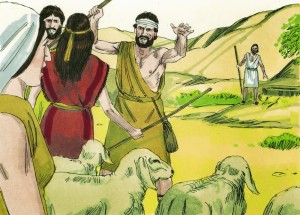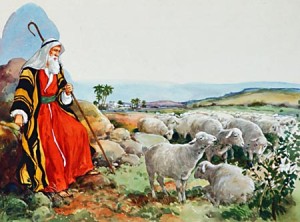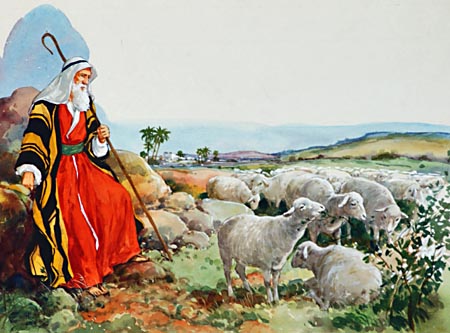Raboyseyee and Ladies
The Ubiquitous Staff (Shtekin)
Let’s start here: What did Odom, Chanoich (Enoch), Misushelach, Noiach, Shem, Avrohom, Yitzchok, Yaakov, Yoisef, Yehudah, Tamar, Yisroy and Moishe have in common? Nu, mistama you were thrown by the inclusion of Yehudah and Tamar. While you’re thinking, let’s learn some parsha. Avada, we will properly address this question and then some; that will be topic number two which is also related to topic one.
 Earlier this week, the Oisvorfer was talking to a chaver who said something like this: ‘I am a grown man and my father is still on my case and bothering me about not learning enough Toirah and Gemora.’ That got the Oisvorfer thinking about learning vs. earning, and or, learning vs. saving the world with random acts of kindness. What’s more important in the eyes of the RBSO – learning the heylige Toirah, or, doing tikun oilom (repairing the world by helping others)? Avada it would be givaldig to do both, ober, which takes preference? And what if there is only time and energy for one? Or, what if a person hates to or cannot learn but excels in chasodim (good deeds)? Shoin, let’s think on that; we will zicher address that kasha soon and tie it into the parsha mamish, ober ershtens (first), let’s properly introduce parshas Shemois with a combination of background and overview.
Earlier this week, the Oisvorfer was talking to a chaver who said something like this: ‘I am a grown man and my father is still on my case and bothering me about not learning enough Toirah and Gemora.’ That got the Oisvorfer thinking about learning vs. earning, and or, learning vs. saving the world with random acts of kindness. What’s more important in the eyes of the RBSO – learning the heylige Toirah, or, doing tikun oilom (repairing the world by helping others)? Avada it would be givaldig to do both, ober, which takes preference? And what if there is only time and energy for one? Or, what if a person hates to or cannot learn but excels in chasodim (good deeds)? Shoin, let’s think on that; we will zicher address that kasha soon and tie it into the parsha mamish, ober ershtens (first), let’s properly introduce parshas Shemois with a combination of background and overview.
17 years had passed from Parshas Vayigash to Vayichi. That was last shabbis. This shabbis, as we begin the great book of Exodus and parshas Shemois, a few hundred years have passed, proving avada that the RBSO was certainly selective in what He included and didn’t in His heylige Toirah. Why were certain events omitted, ver veyst! The short answer is azoy: He didn’t feel like including stam history! Our rabbis will teach us that the heylige Toirah is not a history book; accordingly, one will only find the 613 mitzvois and other relevant information in the Toirah. Ober the emes is that quite a bit of Jewish history is included and mistama it’s there to teach us something? What? Nu, our job is to learn the Toirah and figure it all out. The bottom line: He was its author and He was the final arbiter of what, in the end, made it in and what didn’t.
In any event, just last week the Yiddin were prospering over in Goishen ober this week, they are mamish enslaved and have seemingly been so for over 200 years. Anyway, it’s time for them to go; the RBSO has for reasons unclear, decided to commute their 400 year stay to 210 and as Shemois opens, it’s year 210. What terrible crime did the Yiddin commit to have been sentenced to 400 years, ver veyst? A long time ago, way back in Lech Lecho (Bereishis 15:13), the RBSO told our zeyda and forefather Avrohom that his children would be ‘strangers in a land that does not belong to them.’ Ober, when freed, they would leave with great wealth. He did not tell Avrohom why. And while parshas Shemois details the slavery and the ensuing hardships, the emes is that the Yiddin weren’t enslaved for 400 years or even 210. A number of medroshim will teach us that the 400 year number includes many good years during which time the Yiddin were guests and living in the suburbs of Mitzrayim much like the Yiddin today live in the 5 towns and other upscale neighborhoods. The enslavement period was much shorter. Anyway Avrohom didn’t ask too many questions -none at all- once he heard that his family would leave with great wealth. Neither did Yitzchok, nor Yaakov ask for clarification. Years later, Yaakov was lured into moving to Mitzrayim so that he could see and be reunited with his long lost son, Yoisef, for whom he longed 22 years. Ober as we have discussed in the past, the RBSO has a long memory; He does not forget. Once he forecasted this news to Avrohom, it was set in stone. For some of us, that is not good news!
In any event, having decided to free the Yiddin from slavery, the RBSO decided to appoint a representative that would lead the charge and His people out of Mitzrayim. Moishe was his name. Not quite yet as he wasn’t yet born, ober, as Shemois opens we will avada read about his birth during challenging times, his river cruise in a basket, how he was fetched out of the river by an Egyptian Princess who happened to be Paroy’s own daughter, how and why she named him Moishe (the name stuck), how he refused to nurse from the breasts of other Mitzri women, how he grew up in Paroy’s palace and much more. The RBSO set the stage for the ultimate revenge on Paroy -farbrecher that he was (bad guy). Paroy had decreed that all male Jewish babies be thrown into the river, and wouldn’t you know – ironically, the RBSO had the last laugh -doesn’t He always- and set events into motion so that Paroy’s own daughter Bisya would fetch this little Jewish baby from the river and that he – baby Moishe- would be raised in the king’s palace, mamish. One cannot write a better script. Hollywood avada gave it some effort, ober nothing compares to the myseh as read in the heylige Toirah.
We will meet Moishe as a baby, then again when he’s mistama a teen -one medrish will tell us he was but 12 years old- and will accompany him as he skedaddled out of Mitzrayim after killing one Mitzri and then a day later being involved in another altercation – this time between two Yiddin. Moishe will be on the run mamish from his step-zeydah. We will catch up with him as he arrives to Midyan, finds a few available girls at the well -where else- marries one (maybe two), has children and is all of a sudden 80 years old when already selected by the RBSO. Moishe did not readily accept the mission and the medrish will tell us that he and the RBSO were in negotiations for seven days mamish before Moishe acquiesced and accepted his role to travel back to Mitzrayim.
 In past years, we asked and answered questions about the missing years of Moishe’s life. Where the hec was he for so many decades? We offered different medroshim that talked about him being the King of a country called Kush, a wife and children he may have sired while king -it’s avada good to be the king- and about his other wife and kids he fathered while in Midyan. Shoin, if some of this is shocking to you -Moshe had another wife and kids and was a king?- check out the Oisvorfer’s previous postings on this parsha. They are mamish alarmingly insightful, educational, and quite well written. Shoin another unabashed plug for www.oisvorfer.com. Non-email traffic remains stuck between 73 and 78,000 weekly and we’re trying to get to 100,000 hits. Veyter.
In past years, we asked and answered questions about the missing years of Moishe’s life. Where the hec was he for so many decades? We offered different medroshim that talked about him being the King of a country called Kush, a wife and children he may have sired while king -it’s avada good to be the king- and about his other wife and kids he fathered while in Midyan. Shoin, if some of this is shocking to you -Moshe had another wife and kids and was a king?- check out the Oisvorfer’s previous postings on this parsha. They are mamish alarmingly insightful, educational, and quite well written. Shoin another unabashed plug for www.oisvorfer.com. Non-email traffic remains stuck between 73 and 78,000 weekly and we’re trying to get to 100,000 hits. Veyter.
Ober this year, we will focus on two areas only. Ershtens, what was Moishe’s profession before the RBSO selected him to negotiate with Paroy for the release of the Yiddin? Was he a hostage negotiator in a previous life? Not! Instead, the heylige Toirah will tell us that he was a shepherd. Shoin, also a nice profession for a nice Jewish young man. And guess what? He wasn’t the first, nor the last to have been busy all day with behaymis (animals) and then to have been selected by the RBSO for greatness and or leadership. And what was his bashert, Tzipoira, and her sisters doing when Moishe encountered them at the well? Reciting the Tashlich prayer? Not! They were busy at the watering troughs after a day of herding their father’s animals. Shoin, Tzipoirah too was a shepherdess.
And shtelt zich di shaylo azoy (the question arises): Why did the RBSO seem to favor shepherds for greatness? Which other Toirah personalities began their careers as shepherds? Let’s count them. Seemingly, all our Ovis (forefathers) were shepherds. It’s emes: Avrohom, Yitzchok and Yaakov, were all shepherds. Yaakov worked as a shepherd for his shver Lovn for a total of 20 years. Moreover, so was Rochel and that’s taka how he met her; she had just arrived to the well to water her father’s sheep. And let’s roll back the clock to Vayigash and recall that Yoisef’s brothers were all shepherds. Wait, there’s more. Let’s roll back to parshas Vayeshev and recall that it was while Yoisef was out shepherding his father’s sheep, that he ran into his brothers who were also shepherding. Even more: Let’s recall that Yoisef, post reconciliation, presented a few of his brothers to Paroy and introduced them as shepherds. And, let’s recall the shevotim telling Paroy that ‘our fathers’ -meaning avada a few generations back- were also shepherds. Shoin, now we can chap why they were selected for greatness despite their otherwise questionable behavior with Yoisef. They were qualified: they were shepherds. And again we ask, what was so great about being a shepherd?
And before we answer with a medrish or two that will enhance your shabbis tish, let’s move the clock forward from the heylige Toirah to another part of our glorious history where we will learn that a young boy named Dovid was plucked from obscurity mamish to become king of the Yiddin. What was he doing? He was a shepherd, what else?
And the shaylo iz azoy: if we chap that historically the RBSO loves shepherds and has selected more than a few for greatness, why are we wasting our time in yeshiva and college? Did we learn anywhere that Avrohom or Yitzchok spent years learning in a yeshiva? Were they holed up in some yeshiva for shono beit or gimmel? Were they in a koilell over in Lakewood? Not! Did they learn in any yeshiva? Mistama not though Rashi will tell us that Yaakov did spend 14 years over at the maybe mythical yeshiva of Shem and Ever. Ober, let’s not forget that this yeshiva may have existed on paper only and only for those whose years we could not account for. Was Yoisef a learner? And was Moishe shteyging over the Gemora or trying to chap pshat in a Rebbe Akiva Eyger before being appointed as leader supreme of the Yiddin? Why did so many of the original leaders and role models of the Yiddin elect to become shepherds? Nu, es veyst zich ois that being a shepherd was mamish the key to success, ober why?
Nu, one thing we know for sure about shepherds: most of them sit around doing nothing for many hours a day. They have time to think and daydream. Grada that part sounds very much like a yeshiva for most, and efsher taka that’s why the yeshiva eventually replaced shepherding, ver veyst. Our rabbis will teach us that having lots of time to think is an absolute prerequisite for becoming a prophet. It’s during this time of deep thinking that one can become elevated to higher spiritual levels and can then transcend physical reality. Then again, one can certainly become elevated by sitting in yeshiva and daydreaming, or, by sitting near the wrong rebbi, if you chap.
 And says the medrish (Shemois Rabah 2:2) so gishmak azoy: Moishe was shepherding his shver’s sheep one day when one of them bolted. Moishe gave chase. The sheep stopped near a body of water and began to drink; it was mamish just thirsty. Said Moishe to the sheep: If only I had known that you are nebech thirsty for some water. You poor shepsele, you must be exhausted from running over here. Moishe then scooped up the shepsel (sheep), placed it on his shoulders and headed back to his flock. The RBSO was avada observing Moishe as this myseh unfolded and said azoy: if this is how Moishe cares for the sheep of man, he is avada fit to shepherd Mine. Shoin, do you see how beautiful a medrish can be? Who says it has to be emes? Of course, it might just be. And is that gishmak or what?
And says the medrish (Shemois Rabah 2:2) so gishmak azoy: Moishe was shepherding his shver’s sheep one day when one of them bolted. Moishe gave chase. The sheep stopped near a body of water and began to drink; it was mamish just thirsty. Said Moishe to the sheep: If only I had known that you are nebech thirsty for some water. You poor shepsele, you must be exhausted from running over here. Moishe then scooped up the shepsel (sheep), placed it on his shoulders and headed back to his flock. The RBSO was avada observing Moishe as this myseh unfolded and said azoy: if this is how Moishe cares for the sheep of man, he is avada fit to shepherd Mine. Shoin, do you see how beautiful a medrish can be? Who says it has to be emes? Of course, it might just be. And is that gishmak or what?
Moreover, we can kler that shepherding large groups of animals, is good practice for leading larger groups of living creatures, like humans. Sheep herding was seemingly just a resume builder and the excellent hands-on practical experience that future leaders of that time needed and what the RBSO was looking for.
And the bottom line: Efsher we can kler azoy: the type of leadership the RBSO was looking for (at least back then) was not to found in a yeshiva or even in college. Seemingly, He wanted those that through the experience of shepherding, demonstrated a sense of compassion to the most vulnerable. Those who showed sensitivity to every animal in their flock. Those very people would had the same sensitivity to the needs of each of their constituents. Shepherds have great experience in dealing with large groups of living creatures and are likely in a position to deal with large groups of people; even when a number of them act like behaymis (animals).
Said Rabbi Avrohom Yitzchok Kook, he the first chief rabbi of pre-state Israel, azoy: the advantage of shepherding may be found in the secluded lifestyle of the shepherd. While engaged with flocks, ambling through the hills and valleys, the shepherd, is cut off from the noisy distractions of society, thus enabling ample time for inner reflection. And says the medrish so gishmak azoy (Shemois Rabbah Ch 2): The RBSO does not give a man greatness until He tests him as a shepherd.
Ober, did Moishe get the call stam because he was but a shepherd? Mistama not; though avada the RBSO took note of his compassion and sensitivity to animals. Says the Alter of Kelm (Rabbi Smcha Zissel Ziv) azoy: Moishe got the call because he possessed the mida (trait) of nosei b’ol im chaveroi – sharing his fellow’s yoke. And with that trait, it was natural for him to intervene when the Mitzri was whacking the Yid and again when two Yiddin were fighting. He will do the same for seven strange girls he meets at the well. Es vyst zich ois (seemingly), being in tune with the needs of others, be they chaverim or even strangers, and helping out when possible, are qualities the RBSO looked for.
 And how old was Moishe when he demonstrated these unusual character traits? Says the Ramban: he was but 12. Impressive! Says Rav Zissel: What Moishe demonstrated with the three recorded incidents was his intolerance of injustice. He felt the pain of those being aggrieved. He wanted to and did help those in need of assistance. And what can we efsher learn from this? Seemingly, Moishe was selected for his good deeds and not his ability to learn Gemora. So to my chaver’s parents who continue to push his learning vs. his doing chasodim, says the Oisvorfer azoy: be proud instead of all his good works which are countless. Shoin, many of you will be asking who the mystery chaver is, ober, as you know the Oisvorfer doesn’t talk, if you chap.
And how old was Moishe when he demonstrated these unusual character traits? Says the Ramban: he was but 12. Impressive! Says Rav Zissel: What Moishe demonstrated with the three recorded incidents was his intolerance of injustice. He felt the pain of those being aggrieved. He wanted to and did help those in need of assistance. And what can we efsher learn from this? Seemingly, Moishe was selected for his good deeds and not his ability to learn Gemora. So to my chaver’s parents who continue to push his learning vs. his doing chasodim, says the Oisvorfer azoy: be proud instead of all his good works which are countless. Shoin, many of you will be asking who the mystery chaver is, ober, as you know the Oisvorfer doesn’t talk, if you chap.
Shoin, we opened by asking what certain well known Toirah personalities had in common. The list included Odom, Chanoich (Enoch), Misushelach, Noaich, Shaim, Avrohom, Yitzchok, Yaakov, Yoisef, Yehudah, Tamar, Paroy, Yisroy and Moishe. And the answer is the shtekin, or, as the heylige Toirah refers to it -the Mateh- the staff. A medrish (Pirkei Di’ Rebbe Eliezer 40) will tell us a fabulous story, let’s learn it. Ober before we do, it’s a good time to point out that that Rebbe Eliezer Ben Hurkanus, an early 2nd century Tanna, though born into a prominent family that could easily afford the best yeshivas, did not know any Toirah. Legend has it that he could not recite the Shemah, Shmoineh Esray or benching -something he grada had in common with many yeshiva boys of today’s generation, oy vey. In any event, at age 28, he made his way to Yirusholayim and began leaning with Rebbe Yoichonon Ben Zakai. He went on to become a great scholar and the heylige Gemora (Buba Metzia 59B) tells us that a ‘bas kol’ (Heavenly Voice) proclaimed that halocha (law) is always according to Rebbe Eliezer. Also quite impressive. In any event, he authored a volume of Medroshim which the Oisvorfer has been quoting from of late. And his account of the famous shtekin that Moishe traveled with, did magic with, brought about a number of the plagues with and later split the sea and produced water with, goes like this. WARNING: Whether this medrish is emes or not, ver veyst, ober a most creative and colorful approach it certainly is.
 Said he: The original shtekin (staff) was created by the RBSO during Bein Hashmoshis (dusk) on the 6th day of creation. Whether it was fashioned out of sapphire or wood is of course in dispute. As an aside, it was but one of ten items created that were set aside by the RBSO who would pull them out of inventory at the appropriate time. This part can be found in the Mishne (Ovois 5:6). We will come across a few of them as we make our way through the other good seforim of the Toirah. According to Rebbe Eliezer, this special staff was first given to Odom Horishon, efsher to help him traverse Gan Eden. Odom passed it on to Chanoich (the heylige Toirah will tell us that Chanoich was a good guy). From there it went to Misushelcah (Methuselah) who was efsher advanced in years, and maybe needed some help walking. From there it went to Noaich who may have used it to tame the animals, his son Shaim who may have used it make sure his students didn’t escape, Avrohom, Yitzchok and then Yaakov. Avada you will recall that back in Vayishlach, Yaakov will sate ‘but with my staff did I cross the river Yabok.’ Yaakov of course gave the shtekin to his favorite son Yoisef.
Said he: The original shtekin (staff) was created by the RBSO during Bein Hashmoshis (dusk) on the 6th day of creation. Whether it was fashioned out of sapphire or wood is of course in dispute. As an aside, it was but one of ten items created that were set aside by the RBSO who would pull them out of inventory at the appropriate time. This part can be found in the Mishne (Ovois 5:6). We will come across a few of them as we make our way through the other good seforim of the Toirah. According to Rebbe Eliezer, this special staff was first given to Odom Horishon, efsher to help him traverse Gan Eden. Odom passed it on to Chanoich (the heylige Toirah will tell us that Chanoich was a good guy). From there it went to Misushelcah (Methuselah) who was efsher advanced in years, and maybe needed some help walking. From there it went to Noaich who may have used it to tame the animals, his son Shaim who may have used it make sure his students didn’t escape, Avrohom, Yitzchok and then Yaakov. Avada you will recall that back in Vayishlach, Yaakov will sate ‘but with my staff did I cross the river Yabok.’ Yaakov of course gave the shtekin to his favorite son Yoisef.
Now we need to veer off the medrish for a moment and recall that Yehudah too used a shtekin – did he ever, if you chap, maybe the same or perhaps another, and then gave the shtekin to Tamar as a mashkin (collateral) to ensure payment for his roadside services, if you chap. Seemingly, he left home without his AMEX and or cash, a mistake one should never make on the road, if you chap. The shtekin is seemingly ubiquitous! Grada, Tamar’s plan to ensnare Yehudah’s shtekin, led to the seeding of Kings of the Yiddin and one day soon, to the Moshiach himself. How all that works up in the RBSO’s engineering department, ver veyst. CAUTION: Telling your eishes chayil that you had a roadside encounter to seed a king or the Moshiach, will not get you off the hook.
Shoin, what became of the shtekin following Yoisef’s passing? Continues the medrish: Seemingly it went to house of Paroy and somehow later, into the hands of Yisroy who according to another medrish was one of Paroy’s three advisors (with whom he discussed his enslavement plans). Some say that Yisroy was silent as the plan unfolded and ran away from Paroy. But not before he chapped the shtekin which may have caught his eye because of the special letters etched into the shtekin. Shoin, Yisory get home safely to Midyan, inspected the shtekin and noticed that it had 10 letters etched into it, each representing one of the 10 makos that the RBSO was planning to bring on Mitzrayim. Some say it also had the RBSO’s initials or full name. Shoin wouldn’t it be amazing mamish were we to find out that it was inscribed with the letters R-B-S-O? Shoin back to the story.
So here is Yisroy with the shtekin. He decided to plant it in his garden and stated that whomever will successfully pull the shtekin out of the garden, will likely be the redeemer of the Yiddin. And to whomever might be successful, he offered an additional prize; his beautiful daughter Tzipoirah as a wife. She was the daughter that accompanied Moishe to Yisroy’s house after he saved the girls from sexual molestation at the hands and maybe shtekins of the Midianite shepherds who were making advances on the 7 hapless girls. Shoin everyone likes to pull on a shtekin, if you chap, and there were many suitors. Seemingly, none were successful; every shtekin puller failed and the shtekin remained implanted in the garden. Along came Moishe who was punkt wandering in the backyard. What Moishe was doing in the yard is the subject of yet another medrish we previously discussed. The shtekin caught his eye -mistama the inscriptions- and he easily removed it from the earth. Yisroy was amazed and allowed Moishe to marry his daughter Tzipoira. Mazel tov. And as a wedding present, Moishe was now the proud owner of the shtekin which as we stated above, would perform all sorts of magic over the next 40 years. Sadly, shtekin play or shtekin abuse can also cause problems and avada you all recall how Moishe’s visa into the land was eventually cancelled because he used his shtekin incorrectly. We have avada warned you many times before about shtekin abuse; proceed with caution.
Some say what’s amazing about the shtekin is that it was used for both holy and unholy acts. At one point, it was thrown to the ground and it turned into a snake. A moment later, it was stiff again and holy. Could the shtekin teach us life lessons? Can we and our shtekins be both holy and not? Seemingly yes.
A gittin Shabbis and a Happy New Year!
The Oisvorfer Ruv
Yitz Grossman
